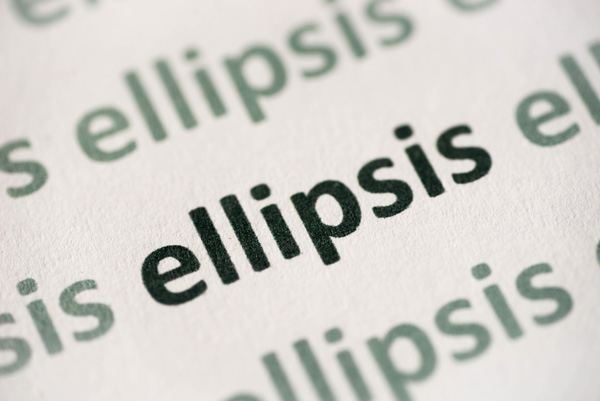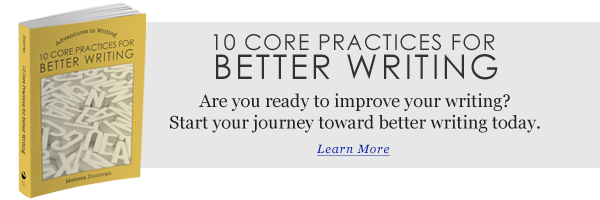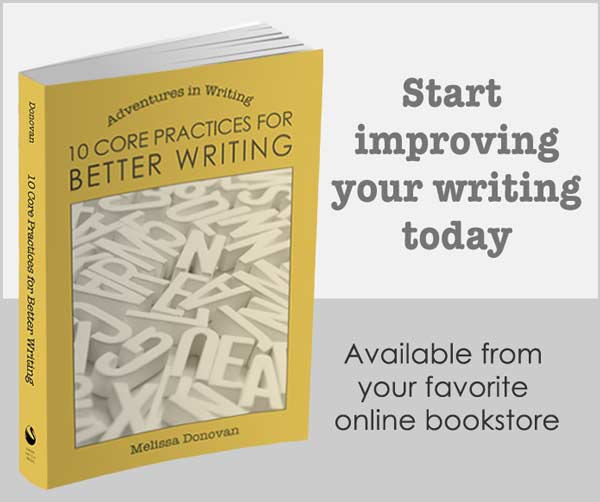You see it everywhere, but most people don’t know what it’s called or how to use it properly.
In fact, it’s often referred to as “dot, dot, dot” even though it does have a name. This punctuation mark is the ellipsis.
It is a series or row of three periods, which is usually used to indicate an omission. It may also be used to indicate faltering or interrupted speech or a pause.
Punctuation Marks
Some punctuation marks are clear-cut while others cause a lot of confusion. Most of us mastered periods and question marks back in elementary school. Commas, semicolons, and ellipses aren’t as easy to master. As a result, many punctuation marks are frequently misused.
The ellipsis is one such punctuation mark. Most people don’t know the name of this punctuation mark, and those who do often confuse the singular and plural (just as many people confuse singular datum and plural data).
Luckily, the ellipsis isn’t nearly as confusing as the comma. It’s relatively easy to learn how to use it correctly and how to refer to it properly.
Ellipsis
According to The Chicago Manual of Style:
An ellipsis — the omission of a word, phrase, line, paragraph, or more from a quoted passage — is indicated by ellipsis points (or dots)… Ellipsis points are three spaced periods ( . . . ), sometimes preceded or followed by other punctuation.
Singular and Plural
The word ellipsis is not plural. In other words, it refers to the three points, together, as a single unit, which is often colloquially referred to as dots or periods. Here is an ellipsis:
. . .
The plural of ellipsis is ellipses. This would indicate more than one set of three dots:
. . . . . . . . .
This punctuation mark may also be called a suspension point, points of ellipsis, or periods of ellipsis. But to keep things simple, let’s just stick with the word ellipsis.
Omissions
The ellipsis is primarily used to indicate an omission. It can be an intentional omission, such as when you’re using a quotation but want to skip over a portion of it. Consider the following quote from Stephen King:
Fiction writers, present company included, don’t understand very much about what they do — not why it works when it’s good, not why it doesn’t when it’s bad.
If space is tight, you might want to omit part of the quotation, but you still need to indicate a missing piece of text. You would use an ellipsis:
Fiction writers . . . don’t understand very much about what they do — not why it works when it’s good, not why it doesn’t when it’s bad.
Faltering or Interrupted Speech
The ellipsis may also be used to represent faltering or interrupted speech:
“Well, I . . . uh . . . don’t know,” she said.
Pauses
We can also use an ellipsis to indicate a pause or unfinished thought. At the end of a sentence, an ellipsis represents trailing off into silence.
Using an ellipsis to represent a pause can get a writer into trouble. We tend to pause a lot in speech. Pauses give us a moment to collect our thoughts or add emphasis to what we’re saying. But in writing, a page peppered with ellipses wreaks havoc on the eyes.
The same applies to unfinished thoughts. A lazy writer might use ellipses to indicate, “and so on” or “et cetera.” In text messaging and social media, many people use ellipses where they believe the reader will implicitly understand what would be stated next. In professional-grade writing, we finish our thoughts, so ellipses used for this purpose should be rare.
However, when we are writing dialogue, an ellipsis can come in handy, especially if we want to show a character’s speech trailing off. Keep in mind, though, that ellipses, like exclamation points, should be used with caution and only when truly needed for emphasis. As a general rule, don’t use it unless you must.
Notation and Formatting
You’ll see ellipses formatted in two ways, either three points without spacing (…) or three points with spacing ( . . . ). In some cases, four points are used, but this is rare and not covered in this article.
In the U.S., an ellipsis is generally formatted with spacing between each ellipsis point: ( . . . ) per the most common style standards.
The Chicago Manual of Style warns against using ellipsis at the beginning or ending of any quotations. However, some writers will place ellipses at the beginning or endings of quotations to indicate preceding or following text that has been omitted. This ensures that readers are aware of omissions and prevents using quotations out of context.
Using Punctuation Marks Like the Ellipsis
If you want to ensure you’re using grammar and punctuation marks correctly and consistently in your writing, pick up a grammar manual or style guide. You’ll find that the more you write, the more frequently you come across grammar and formatting situations that are unclear. Grammar and style resources will be a great help.






So, are . . . and … interchangeable? You used one for omission and the other for pause in the examples, which left me wondering… <== Ooh, look at that. Unprofessional usage.
It depends which style guide you’re using. The important thing is to be consistent. I just made them consistent in this piece, so now they’re the same 😉 Thanks Kelvin.
Good article, thanks for sharing!
Thanks, Helen.
Is it really Thanks, Helen? Or is it Thanks Helen.
It’s really “Thanks, Helen.” I’d recommend looking things up before challenging them on a public forum.
What a great overview of all the uses for the ellipsis. I tend to use them a lot in my own writing, and this info really sheds some light on when the right time and place to do so is, so to speak. Anyway, great article!
Thanks, Vanna. I have come to view ellipses as a crutch, a space-filler that writers use when they don’t want to finish a sentence or use action to demonstrate a pause. My own rule is to use them as rarely as possible; that way, they have a greater impact when they do appear (the same is true of exclamation marks).
This is fantastic, Melissa. One of my pet peeves is how often some writers use ellipses at the end of the sentences, which as you point out, is an indicator of trailing off into silence. But so many don’t know to use it that way. Love them to death, but I’ve noticed a lot of my screenwriting friends are ellipses happy and I’m not sure why.
I notice it a lot in emails, which is what inspired this post. In fact, I’ve seen many instances where the ellipses are used where a period would suffice. Punctuation has become rather subjective in the information age!
GUILTY…
🙂
Thanks for a good article Melissa. Will be back for more.
Dear Melissa
Youyr article was a real confidence builder for me. Thanks.
Thanks, Kathleen!
Hi Melissa,
Never ever thought that punctuation could be described as creatively, till I read your blogs.You make it sound so easy.
There is plenty of information available on the use of punctuation for prose, but have been trying desperately to find the use of punctuation for poetry and not been able to find this.Can you help?
How much creative liberty is allowed for punctuation marks in poetry?
Can poetry end with ellipsis be used at the end of each thought and sentence in poetry to connect the next sentence. But how often?Is it grammatically correct or incorrect?
Does every sentence in verse have to begin with a capital letter, even though the next thought is connected and ends with a comma or a semicolon?
What is a good book for punctuation for both poetry and prose writing style.
Would love to hear from you.
B/ Rgds
Cora
In poetry, there is a ton of room for creativity. I’m actually working on a post about grammar and poetry, but here are a few insights:
I tend toward minimalism with regard to punctuation in poems — I want each punctuation mark to really mean something; otherwise, it gets cut.
My best suggestion for you is to pick up a book that will teach you punctuation in general. I use the big one – Chicago Manual of Style. But what you really need to do is read published poetry. Get a few books of poems by well known poets, pick up a few poetry journals. Online, I strongly recommend subscribing to Rattle. Familiarizing yourself with the poetry that’s out there is your single best bet for picking up all this stuff, and this is, in large part, due to the creative liberty that poems afford. You’ll eventually find a style that suits you.
I love this! This is the first time I’ve found a blog on punctuation. I just read a book that seems to need some help. I love the story line, I just find it difficult to get past some of the things the writer does. ie: “let. me. go.” That is actually used more than once in the book. This is a series, so you can only imagine the punctuation mistakes. I’m no writer, and I know I must make many mistakes. But, I do hope they aren’t as glaring as those. My question to you is, what is the correct way for this author to get her point across. It’s been a month since I read the book, but that just keeps on nagging my thoughts.
The construction you’ve asked about (let. me. go.) is becoming more and more popular in writing. Here we have an author using the period to indicate a full stop in speech. I would feel better about this construction if the words were capitalized and if it only occurred rarely in the writing. It’s acceptable for writers to take creative liberties with punctuation but as you can see, it’s also risky. Some readers just won’t like it. The technically correct way for the author to write this would have been as follows: “Let me go.”
I don’t have a problem with the full stop after individual words to indicate the pause between words, but I would be annoyed by the lack of capital letters.
The purpose of punctuation is to make the meaning clear. If it doesn’t do that, or leaves it ambiguous, then it’s incorrect. And, in my opinion, that also applies to poetry.
Different people will have different reactions to this type of construction. It is important for creative people to take liberties with language and experiment with it. However, doing so will certainly rub some people the wrong way. For me, it just depends on the context. Sometimes it works; sometimes it doesn’t.
What is a good way to use ellipses (or some other punctuation mark) to indicate a prompt-and-answer in an interview? e.g. (Interviewer): If I had a billion dollars I would
(Interviewee): Give the money to my wife and get back to work.
Is the following layout ok for the 10th such question-and-answer?
10. If I had a billion dollars I would . . .
. . . Give the money to my wife and get back to work.
I wouldn’t use ellipses in this case. Since it’s a formal interview, here’s how I would construct it:
Interviewer: What would you do if you had a billion dollars?
Interviewee: I would give the money to my wife and get back to work.
Thanks :o)
I’m curious about how you worded this statement you made above:
“However, when we are writing dialogue, an ellipsis can come in handy, especially if we want to show a character’s speech trailing off. Keep in mind, though, that ellipsis, like exclamation points, should be used with caution and only when truly needed for emphasis. As a general rule, don’t use it unless you must.”
I would have said, “Keep in mind, though, that ellipses, like exclamation points, . . .
or
“Keep in mind, though, that an ellipsis, like an exclamation point, . . .
My understanding is that the noun “ellipsis” refers to all three points as one unit. Would you clarify your usage for me?
Thank you!
P.S. After I clicked on the “Submit” button, it was too late to correct an oversight I noticed in my last comment. I believe I should have put a space after the last comma before the ellipsis in each sentence.
I guess we both made a typo 😉
I have a question about how ellipsis are written or key stroked.
If, for exmple I write “all men are created equal…some more equal”. Is it correct to have the ellipsis begin immediately after the L in equal and end immediately before the S in some? or should there be a space after L and before S?
Hi Tim. The answer you seek is in the post. Check near the bottom.
Hello Melissa, this was a great article. I myself never wondered when … (I’ll still call it dot dot dot, ellipsis seems alien. XD ) is used. Then I was critiquing on the critiquecircle page and there was one writer who was very fond of using this structure. And while learning more about ellipsis I stumbled here. I’m sure your writing will help me a lot. Loads of thanks! : )
You’re welcome! I’m glad you found this article helpful, Aditya.
Thanks, Melissa for this helpful information. 🙂 — Suzanne
You’re welcome, Suzanne.
I use the ellipsis at times in my writing but hardly ever in e-mails or texts.
What’s up with the lower-case “k” instead of writing “Okay” or “Ok”? Does that mean that person is responding grudgingly? I don’t care for it.
I don’t know about the lowercase “k.” Sounds like some kind of shorthand.
This is fantastic advice, Melissa – thank you for this. Toni x
You’re welcome!
Errands with the… hardly bother me, but I am abhor authors who start sentences with conjunctions constantly. I will actually put the book down. Can you speak to that.
I’m not sure what you mean by “Errands with the…” How are errands relevant?
Also, I think it’s an overreaction to “abhor authors” who start sentences with conjunctions, whether they do it constantly or rarely. To abhor is to hate, and that just doesn’t seem like a reasonable and proportional response. With that said, yes, I can speak to it: Anything that’s overdone can be a little annoying, but I certainly wouldn’t put a book down just because a lot of sentences start with conjunctions.
We all have our quirks and bad habits, and we all make mistakes. That’s something I try to keep in mind as a reader.